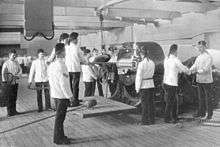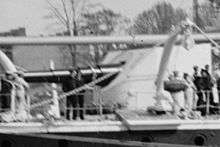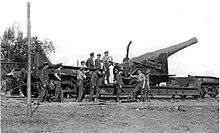BL 9.2 inch gun Mk I–VII
| Ordnance BL 9.2 inch gun Mk I – Mk VII | |
|---|---|
|
Mk VI gun on disappearing mounting at Ben Buckler Gun Battery, Sydney | |
| Type |
Naval gun Coast defence gun |
| Place of origin | United Kingdom |
| Service history | |
| In service | 1881–1918 |
| Used by |
Royal Navy Australian colonies |
| Wars | World War I |
| Production history | |
| Variants | Mk I – VII |
| Specifications | |
| Weight |
Mk I & II : 20 tons barrel & breech |
| Barrel length |
Mk I & II : 230 inches (5,842 mm) bore & chamber (25 calibres) |
|
| |
| Shell |
380 pounds (172.37 kg)[1] 290 pounds (131.54 kg) (High-angle guns)[2] |
| Calibre | 9.2-inch (233.7 mm) |
| Muzzle velocity | 2,065 feet per second (629 m/s)[3] |
| Maximum firing range | 10,000 yards (9,100 m)[note 1] |
The BL 9.2 inch guns Mk I – Mk VII[note 2] were a family of early British heavy breechloading naval and coast defence guns in service from 1881 to the end of World War I. They were originally designed to use the old gunpowder propellants.
History
Mk I and II
British 9.2 inch guns originated from a request by the Admiralty in 1879 for a gun comparable to Krupp's 24 cm (9.45 inch) gun at the time. The Admiralty submitted its request to the Committee on Ordnance, which was considering returning to breech-loading artillery after Britain's brief return to muzzle-loaders in the 1860s and 1870s. A new breech-loading gun with a 9.2 inch (234 mm) bore, firing a 380-pound projectile was calculated to be suitable.[4] A total of 19 Mk I and Mk II guns of 26 calibres were made starting in 1881, but after lengthy delays and modifications still proved unsatisfactory; none made it to sea.
Mk III – Mk VII
The 31.5 calibres versions, Mk III through to Mk VII became the first to be mounted on ships and deployed in general service.
Naval service


Guns equipped the following ships :
- Imperieuse-class armoured cruisers launched in 1883 : Mk III
- Orlando- class armoured cruisers launched 1886 : Mk V & VI
- Blake-class protected cruisers launched 1889 : Mk VI
- Edgar-class protected cruisers launched 1890 : Mk VI
- HMS Alexandra as re-gunned in 1891
- HMS Rupert as re-gunned in 1892
- M15-class monitors M19 – M28 launched 1915 : Mk VI guns from Edgar-class cruisers.
Coast defence gun
Most Mk IV guns and some Mk VI guns were used in coast defences.
In the mid-to-late 1880s successful trials were carried out with RML 9-inch coast-defence guns firing at high angles in order to test the effectiveness of plunging fire on decks of ships. When surplus BL 9.2 inch Mk IV and Mk VI guns became available in the 1890s they were likewise adapted to high-angle carriages, with their obsolete 3-motion breech mechanisms replaced by modern continuous-motion patterns to allow faster loading. Locations included Plymouth and Gibraltar.[5]
The elevation of up to 45° meant that the shell was at risk of slipping back after being rammed forward; only the copper driving band held the shell in place in a BL gun, and they had not been designed to operate at such high angles. The solution adopted was to develop a special high-angle reduced-charge cartridge with a hollow up the centre, through which the gunner inserted a 1 1⁄4-inch-diameter (32 mm) stick about 40 inches long made of beech wood, to prevent the projectile from slipping back before firing. A "light" 290-pound (130 kg) shell was used for high-angle firing, rather than the standard 380-pound (170 kg) shell.[6]
In the late 19th century to early 20th century five Mk IV coast-defence guns were installed at Singapore : two at Fort Connaught on Blakang Mati, one at Fort Siloso on Sentosa Island and two at Fort Pasir Panjang on Singapore Island.[7] Two of these remain at Fort Siloso.
World War I railway gun

From 1915 onwards Elswick adapted a small number of Mk III, Mk IV and Mk VI guns, and mounted them on railway truck mountings for service on the Western Front in France and Belgium.[8]
Australian service
In the late 1880s and early 1890s the Australian colonies between them ordered 10 barrels and nine carriages for BL 9.2 inch Mk VI 'counter bombardment' disappearing guns :[9]
- New South Wales : Three went to protect Sydney Harbour, plus an extra barrel. Of these, one went to Ben Buckler Gun Battery, one to Signal Hill Battery, and one to Steel Point Battery. The barrel of the gun that had been installed at Signal Hill Battery survives on public display at the Royal Australian Artillery Museum at North Fort, North Head. The gun and carriage of the Ben Buckler gun were unearthed in 1984 and await restoration.
- Victoria : Four guns went to Victoria to protect Port Phillip, with two going to Fort Nepean and two going to Fort Queenscliff.
- South Australia : In 1888, South Australia purchased two guns for what was to be Fort Glenelg to protect Adelaide, South Australia. However, the residents of Glenelg, concerned that they might become a military target, were able to block construction of the Fort and so the guns were never installed. The British government bought them back in 1915.[10][11]
Ammunition
-

Ammunition for early Armstrong 25 calibres gun -

Boxer shrapnel shell
Surviving examples
- 2 Mk IV guns at Fort Siloso, Sentosa Island, Singapore
- EOC Mk VII gun No. 7318 dated 1881, originally mounted at Signal Hill, Vaucluse at Royal Australian Artillery National Museum, North Head, Sydney, Australia
- A previously buried disappearing gun at Ben Buckler, Sydney, awaiting restoration
See also
Notes
- ↑ 10,000 yards refers to naval mountings which had limited elevation : Text book of gunnery, 1902. Coast and rail mountings allowed greater elevation and hence range.
- ↑ i.e. Marks 1 to 7. Britain denoted marks (models) of ordnance using Roman numerals until after World War II.
References
- 1 2 3 Text Book of Gunnery 1902, Table XII Page 336
- ↑ Treatise on Ammunition 10th Edition 1915
- ↑ 380 lb shell, with 164 lb brown prism powder or 53½ lb cordite propellant size 30. Text Book of Gunnery 1902. 175 lb brown powder is quoted for the Mk V gun in Text Book of Gunnery 1887.
- ↑ Hogg & Thurston 1972, page 164
- ↑ Hogg & Thurston 1972, page 167
- ↑ Treatise on Ammunition 10th Edition, published 1915. Pages 77, 142. High-angle cartridges were 44lb 12 oz or 16 lb 1 oz cordite MD, firing a 290-pound shell.
- ↑ The Gun Museum. 9.2-inch BL guns
- ↑ Hogg & Thurston 1972, page 168-170
- ↑ David Spethman, "The Garrison Guns of Australia 1788–1962", published by Ron H Mortensen, Inala, QLD 2008. ISBN 978-0-9775990-8-0
- ↑ P.A. Richardson, 1987, Fort Glenelg: The Fort that Never was, University of Adelaide.
- ↑ http://www.heritage.nsw.gov.au/07_subnav_01_2.cfm?itemid=5056455
Bibliography
- Text Book of Gunnery, 1887. LONDON : PRINTED FOR HIS MAJESTY'S STATIONERY OFFICE, BY HARRISON AND SONS, ST. MARTIN'S LANE
- Text Book of Gunnery, 1902. LONDON : PRINTED FOR HIS MAJESTY'S STATIONERY OFFICE, BY HARRISON AND SONS, ST. MARTIN'S LANE
- Treatise on Ammunition, 10th Edition 1915. War Office, UK. Facsimile reprint published by Imperial War Museum and Naval & Military Press, 2003. ISBN 1-8434-2560-2
- Hogg, I.V. and Thurston, L.F. (1972). British Artillery Weapons & Ammunition 1914-1918. Ian Allan, London. ISBN 0-7110-0381-5
- Tony DiGiulian, British 9.2"/31.5 (23.4 cm) Marks III to VII
External links
| Wikimedia Commons has media related to BL 9.2 inch gun Mk I - VII. |
- Video : Demonstration of breech operation
- "Instructions for 9.2 inch Breech Loading Armstrong Gun, and Automatic Barbette Centre Pivot Mounting" instructions for 25.5 calibre Armstrong gun, apparently as supplied to Australian colonies. From National Archives of Australia
- Tony DiGiulian, Britain 9.2"/26 (23.4 cm) Mark I 9.2"/26 (23.4 cm) Mark II

